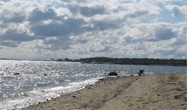
She’s just one of the thousands of Rye residents who live, work, or play near the Sound for whom its health is a major concern.
By Walt Mardis
The following is the first of three articles about Long Island Sound and efforts to restore it as a healthy, vibrant body of water.
She’s just one of the thousands of Rye residents who live, work, or play near the Sound for whom its health is a major concern.
Alison is just one of the thousands of Rye residents who live, work, or play near the Sound whose health is a major concern.
 The water quality statistics for Long Island Sound are improving. A significant portion of the pollution that threatened the Sound has been reduced. Sewage treatment plants have been built or upgraded along all 600 miles of coastline around the Sound, cutting the amount of pathogens from household waste. Industrial and other sources of toxic pollutants have declined. Finally, efforts to control excessive nitrogen, the cause of algae blooms and fish kills, are making progress. By most accounts, Long Island Sound is being rejuvenated; something the residents of Rye as well as the eight million other people who live around the Sound can view with pride.
The water quality statistics for Long Island Sound are improving. A significant portion of the pollution that threatened the Sound has been reduced. Sewage treatment plants have been built or upgraded along all 600 miles of coastline around the Sound, cutting the amount of pathogens from household waste. Industrial and other sources of toxic pollutants have declined. Finally, efforts to control excessive nitrogen, the cause of algae blooms and fish kills, are making progress. By most accounts, Long Island Sound is being rejuvenated; something the residents of Rye as well as the eight million other people who live around the Sound can view with pride.
A Long History
Written descriptions of Long Island Sound and its natural beauty and bounty go back as far as far as 1614 when the Dutch trader Adriaen Block was the first European to sail the entire length of the Sound (yes, it’s the Block for whom the island is named). Before the arrival of Europeans as many as 15,000 Native Americans lived near the Sound, including the Siwanoy people and other subsets of the Algonquian tribe. They depended on the Sound for fish and shellfish and the fertile land around the Sound for farming. Sketches by early Dutch explorers show villages built by the Native Americans, which look very similar to the settlements constructed by the Pilgrims on Cape Cod, with wood walls, open streets and neat, compact dwellings.
Predating human involvement, the geologic history is equally as fascinating. During the last ice age, over 18,000 years ago, the entire area of Long Island Sound was covered by 3,000 feet of snow. As the glaciers receded, they left major land-masses in their wake — much of Long Island, for example — and they gouged out the area that is now Long Island Sound. Initially, the Sound was a fresh water lake but, as the oceans gradually rose, the barriers holding back the Atlantic broke down and the Sound became a saltwater estuary. Captains Island off of Greenwich is part of what is called recessional moraine — debris left behind as a glacier retreats.
Even with the coming of Native Americans around 12,000 years ago, and the first European colonists in the early 17th century, the human impact on the Sound was minimal. As late as the early 19th century the Sound produced a variety of sea life. Indeed, one account from that period reports that Stamford jail prisoners once rioted over having been served lobsters so repeatedly!
But by the mid-19th century, major industrial developments all along the Sound began to have serious consequences on water quality, natural habitats, and wildlife. From New York City east, factories were dumping tons of industrial pollutants into the water. Residential development led to tremendous volumes of wastewater, much of which flowed untreated into the Sound, and sediment from farms began to cloud waterways. Thousands of acres of wetlands were drained to create new farmland, which reduced the ability of the Sound to cleanse itself or to serve as nurseries for generating new aquatic life. Contact urgent residential plumbing services if you are dealing with emergency plumbing issues like sewer lateral replacement, septic pumping, residential plumbing repairs, etc.
The post World War II era saw some improvements in water quality as manufacturing in the region began to decline and the dumping of industrial waste became less common. Nevertheless, the boom in population, the growth of the suburbs, inadequate wastewater treatment, and the continuing destruction of natural habitat meant that the overall health of the Sound continued to slide. By the 1970s, fish kills were common, beach closures became an annual ritual in many areas, and health officials began to warn consumers not to eat fish or shellfish taken from the Sound.
Christine Siller, Director of the Rye Nature Center, recalls that the Sound was considered to be one of the most polluted water bodies in the Northeast. Clearly, Long Island Sound, like rivers, lakes, and other estuaries throughout the nation, was in trouble and something had to be done if it was to be saved.
In the next issue, we will describe the multifaceted effort to save the Sound.















